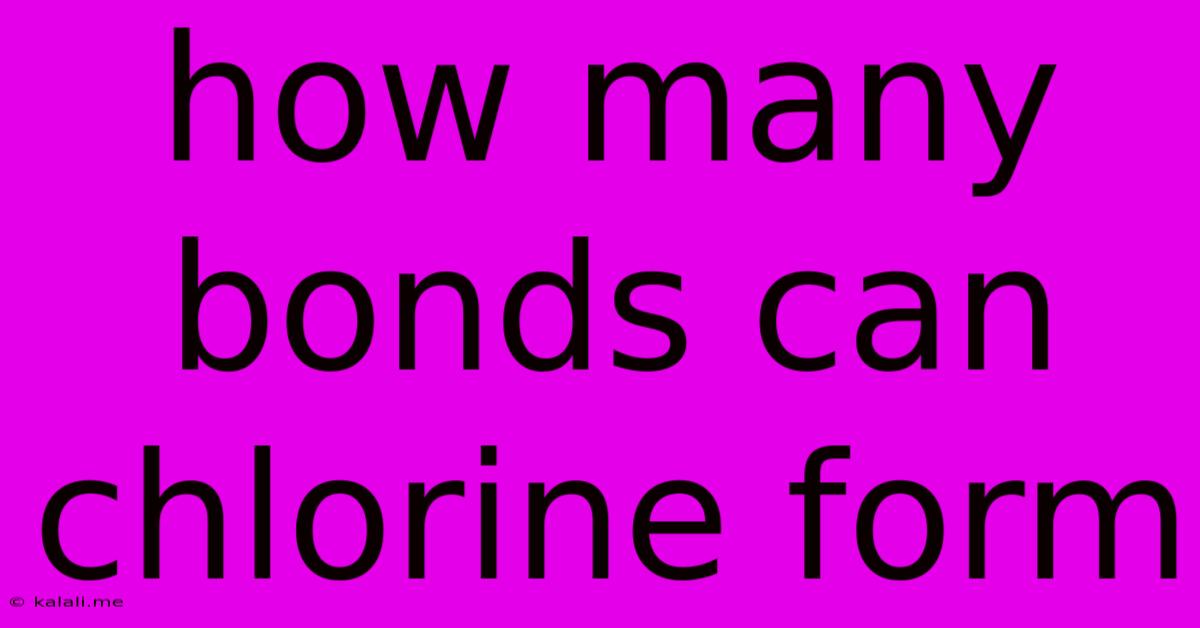How Many Bonds Can Chlorine Form
Kalali
May 09, 2025 · 3 min read

Table of Contents
How Many Bonds Can Chlorine Form? Understanding Chlorine's Bonding Capacity
Chlorine, a vital element with a rich history and diverse applications, possesses a unique bonding behavior. Understanding how many bonds chlorine can form is crucial for comprehending its role in chemical reactions and the properties of the compounds it creates. This article delves into the intricacies of chlorine bonding, explaining its valence electrons, its preferred bonding patterns, and the exceptions to the rule.
Chlorine's Valence Electrons: The Key to Bonding
The number of bonds an atom can form is primarily determined by its valence electrons – the electrons in its outermost shell. Chlorine, with an atomic number of 17, has an electronic configuration of [Ne]3s²3p⁵. This means it has seven valence electrons. To achieve a stable octet (eight electrons in its outermost shell), like the noble gases, chlorine needs to gain one electron. This drive for stability dictates its bonding behavior.
The Usual Suspect: One Covalent Bond
Most commonly, chlorine forms one single covalent bond. In a covalent bond, two atoms share a pair of electrons, effectively completing each other's octets. This is evident in numerous chlorine compounds, such as hydrogen chloride (HCl), where chlorine shares one electron with hydrogen. Similarly, in organic chlorides like chloromethane (CH₃Cl), chlorine forms a single bond with a carbon atom.
Beyond the Single Bond: Exceptions and Considerations
While one covalent bond is the most prevalent bonding pattern for chlorine, there are some less common scenarios to consider:
-
Coordinate Covalent Bonds: Chlorine can participate in coordinate covalent bonds (also known as dative bonds), where both electrons in the shared pair originate from the same atom. This is less frequent compared to regular covalent bonds but can occur in certain complex molecules.
-
Ionic Bonds: In reactions with highly electropositive metals like sodium, chlorine can gain an electron to form a chloride ion (Cl⁻), creating an ionic bond. This is a transfer of electrons, not a sharing, resulting in a strong electrostatic attraction between the positively charged metal ion and the negatively charged chloride ion. Sodium chloride (NaCl), common table salt, is a prime example of this.
-
Higher Oxidation States (Rare): Although extremely uncommon, under specific high-energy conditions, chlorine can exhibit higher oxidation states, potentially forming more than one covalent bond. These situations are usually highly reactive and short-lived, primarily encountered in specialized research contexts.
Understanding Chlorine's Bonding in Context
The ability of chlorine to form one covalent bond is a fundamental aspect of its reactivity and is responsible for its wide range of applications in various industries, including:
- Disinfectants: Chlorine's reactivity is utilized in water purification and sanitation.
- Plastics and Polymers: Chlorine is incorporated into many polymers, contributing to their properties.
- Refrigerants: Chlorofluorocarbons (CFCs), though phased out due to environmental concerns, were extensively used as refrigerants, showcasing chlorine's role in creating specific chemical properties.
- Pharmaceuticals: Chlorine is present in numerous pharmaceutical compounds, playing a role in their therapeutic actions.
In Summary:
Chlorine predominantly forms one single covalent bond, driven by its need to achieve a stable octet. While exceptions exist with coordinate covalent bonds and ionic interactions, understanding this primary bonding behavior is crucial for predicting the reactivity and properties of chlorine-containing compounds. Its single-bond formation plays a significant role in its wide range of applications and chemical interactions across diverse scientific fields.
Latest Posts
Latest Posts
-
2 Out Of 3 Is What Percent
May 09, 2025
-
Was The Hypothesis Repeated Above Completely Supported Justify Your Answers
May 09, 2025
-
What Is 450 Degrees Fahrenheit In Centigrade
May 09, 2025
-
27 Rounded To The Nearest Ten
May 09, 2025
-
What Percentage Is 50 Of 1000
May 09, 2025
Related Post
Thank you for visiting our website which covers about How Many Bonds Can Chlorine Form . We hope the information provided has been useful to you. Feel free to contact us if you have any questions or need further assistance. See you next time and don't miss to bookmark.